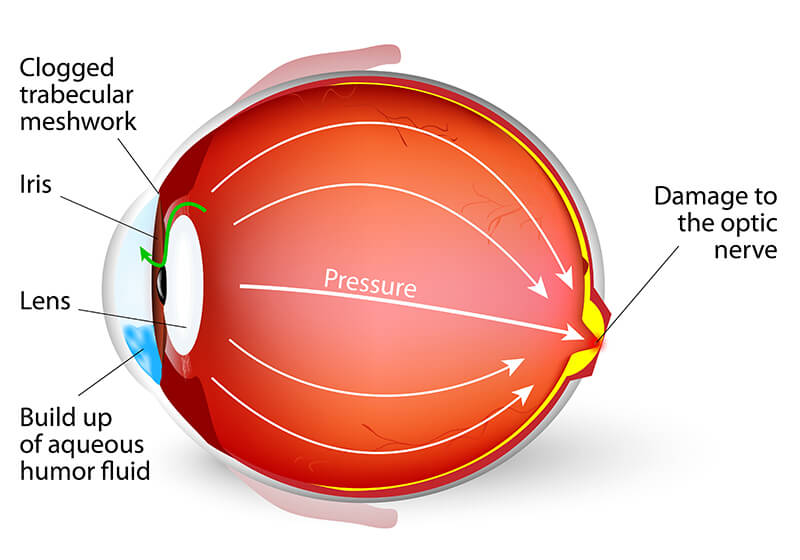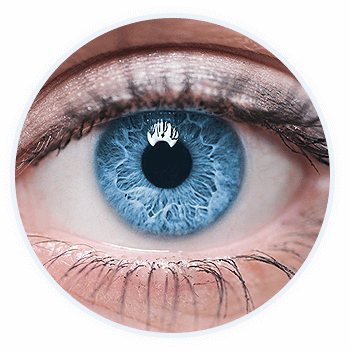The build-up of pressure inside your eye leads to glaucoma. Aqueous fluid, which fills the space at the front of the eye just behind the cornea, is made behind the iris (the colored part of the eye) in the ciliary body. It flows through the pupil (the dark hole in the center of the iris), and drains from the ‘anterior chamber angle,’ which is the junction between the edge of the iris and the cornea. If this outflow of liquid is impaired at all, there is a build-up of pressure inside the eye that damages the optic nerve, which carries visual images to the brain.
The result is a loss of peripheral vision. Thus, while glaucoma sufferers may be able to read the smallest line on the vision test, they may find it difficult to move around without bumping into things or to see moving objects to the side.

Glaucoma Symptoms
Symptoms of glaucoma may be a gradual loss of side vision or blurred vision. Some causes are known, others are note. Causes differ depending on the type of glaucoma.
Types of Glaucoma
Chronic Open-Angle Glaucoma
This is the most common form of glaucoma in the United States. The risk of developing chronic open-angle glaucoma increases with age. The drainage angle of the eye becomes less efficient over time causing pressure within the eye to gradually increase. Increasing pressure in the eye can cause damage to the optic nerve. In some patients, the optic nerve becomes sensitive even to normal eye pressure and is at risk for damage. Treatment is necessary to prevent further vision loss.
Typically, chronic open-angle glaucoma has no symptoms in its early stages and vision remains normal. As the optic nerve becomes more damaged, blank spots begin to appear in the field of vision. You typically won’t notice these blank spots in your day-to-day activities until the optic nerve is significantly damaged and these spots become large. If all the optic nerve fibers die, blindness results.
Closed-Angle Glaucoma
Some eyes are developed with the iris (the colored part of the eye) too close to the drainage angle. In these eyes, which are often small and farsighted, the iris can be sucked into the drainage angle and block it completely. Since the fluid cannot exit the eye, pressure inside the eye builds rapidly and causes an acute closed-angle attack.
Symptoms of Acute Closed-Angle Glaucoma
- blurred vision
- severe eye pain
- headache
- rainbow-colored halos around lights
- nausea and vomiting
An acute closed-angle attack is a true eye emergency. If you have any of these symptoms, call your ophthalmologist immediately. Unless this type of glaucoma is treated quickly, blindness can result. Unfortunately, two-thirds of those with closed-angle glaucoma develop it slowly without any symptoms prior to an attack.
Who gets Glaucoma?
Glaucoma most frequently occurs after age 40, but can occur at any age.
If you’re of African heritage, you are more likely to develop open-angle glaucoma — and at an earlier age — than if you’re Caucasian. Asians are more likely to develop narrow-angle glaucoma.
You have a higher risk of developing glaucoma if a close family member has it or if you have high blood pressure or high blood sugar (diabetes). There is also a greater tendency for glaucoma to develop in individuals who are nearsighted. Those at heightened risk for glaucoma should have their eyes checked at least once a year.
Why is Glaucoma Harmful to Vision?
The optic nerve, located at the back of the eye, carries visual information to the brain. As the fibers that make up the optic nerve are damaged by glaucoma, the amount and quality of information sent to the brain decreases and a loss of vision occurs.
Glaucoma Treatments
As a rule, damage caused by glaucoma cannot be reversed. Eye drops, laser surgery and surgery in the operating room are used to help prevent further damage. In some cases, oral medications also may be prescribed. With any type of glaucoma, periodic examinations are very important to prevent vision loss. Because glaucoma can progress without your knowledge, adjustments to your treatment may be necessary from time to time.
Unfortunately, any vision loss as a result of glaucoma is permanent and cannot be restored. This is why regular eye examinations are important. Glaucoma cannot be prevented, but early detection and treatment can control glaucoma and reduce the chances of damage to the eye and a loss of sight.









